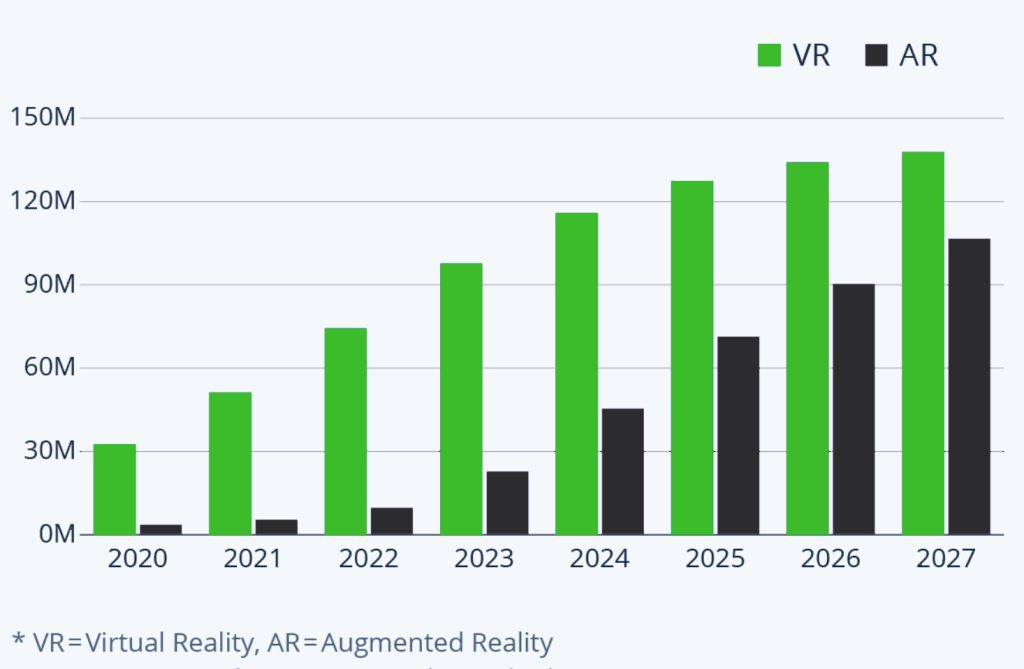In my previous article, I covered why Meta is struggling; If you skipped it, I encourage you to read it before this one. In this summary, I will focus on the plans for Meta and how they want to achieve the long-term goal of creating a space where people will socialize and spend time together – Metaverse. I also will make a reality check where we are with technology and Meta progression in each area.
What is the plan of Meta?
- Be a leader in XR field. Position itself ahead of its competitors and dominate the market
- Reinvent the way people use computers in major use cases like:
- entertainment/gaming
- work environment
- socializing
- Achieve momentum when technology is ready, and their metaverse can count on organic growth and can be monetized on a big scale.
Let’s look at every one of those goals and make a reality check.
1. Be a leader
If we look at the numbers, Meta is ahead, but still, the numbers are not impressive. It’s the early stage of adoption, and it’s hard to say when there will be a consumer market for VR. I predict no sooner than 7-10 years.
Quest 2, their most popular VR headset, sold 15 million copies. Meta Quest has been installed over 21 million times on iOS and Android devices. Compared to other competitors, they are a leader, but we are talking about the low numbers here, so it’s hard to say what the future will bring. Let’s look at this year’s predictions of how the adoption of VR and AR will expand in upcoming years. What is interesting to see: Statista predicts that VR will have faster adoption than AR, and if you check the numbers from three years ago… it was actually quite the opposite – AR was the leader there. This made me think .. this guys seriously have no clue. Together with Gartner, which pointed to XR as a mature technology. We can’t treat those predictions as a base ground for business decisions. For sure, the numbers will grow, but how fast – it’s the finger in the air.

Wrap up:
Meta is the leader for now, but who knows what Apple has in its sleeves? Technologically I would say they are ahead of competitors, but the market is still not consolidated, and it’s not a huge advantage – especially from use cases / software point of view.
2. Reinvent the way we use computer
When revealing Oculus Quest Pro, Mark made a simple statement in his announcement:
“We believe VR devices will help usher in the next computing platform—becoming as ubiquitous as laptops and tablets are today—and that people will use them in their everyday lives to access the metaverse,”
Mark Zuckerberg
Let’s take a closer look at those three categories:
- entertainment/gaming
- work environment
- socializing
1. Gaming:
Gaming seems like the most obvious area to use VR. Yet after a couple of years not too many solid titles in Quest gaming ecosystems. Of course, new titles are coming into it year by year. Some of them are pretty interesting, such as Superhot or Journey of the Gods. But be serious, there is only one king, and it’s Beat Saber.
I had a blast playing this game. It was released a couple of years ago, and there are no real competitors. Why? The answer is – creating games for VR is extremely difficult. There are many pitfalls waiting for designers.
There are a couple of exceptions: VALVE’s hit: Half Life Alyx, released initially on HTC Index, was pointed out by the press and as a game-changer. This game is seriously impressive, and it’s an exciting case that some call forced adoption.
Valve sold 120 000 units of Index, and they need to restock mainly because of the popularity of the game.
I must admit – it was really impressive, but at the same time, there is no other game like Half Life which we can play, and it’s been over two years now after release.
It seems obvious that games are the way to go for VR, but we are still waiting for other blockbusters to take us into another place. Alyx proved it’s possible, but my assumption is – VR it’s too small now to invest colossal money only in it. And the problem is – an experience made for VR doesn’t translate to 2D space and a flat screen. Of course, it’s possible, but the developer needs to decide in which direction he/she wants to lead the experience.
If we look at what Meta is doing internally in terms of gaming – it’s a disaster. It’s barely usable. If you haven’t experienced it yet – there is a good video describing what you can expect there:
2. Work environment
Virtual reality (VR) has the potential to revolutionize the way we work by providing an immersive, interactive experience that can enhance productivity and collaboration. One way that VR could be used in the workplace is by replacing traditional computer monitors with VR headsets.
There are several potential benefits to using VR in the workplace.
First, VR allows for a more immersive and intuitive experience, which can make it easier for employees to understand and interact with complex information and data. For example, a VR headset could be used to display and manipulate 3D models, allowing engineers or architects to visualize and design complex structures.
Second, VR can enhance collaboration and communication by enabling remote teams to work in a virtual environment. For example, employees in different locations could use VR headsets to meet and work in a virtual office, allowing them to share and collaborate on documents and other information in real time. This could be especially useful for companies with global teams or for employees who need to work remotely.
In addition to these potential benefits, there are also some challenges and drawbacks to using VR in the workplace. One of the main challenges is the cost of VR hardware, which can be expensive compared to traditional computer monitors.
Again the answer to this topic.. technology is not ready for long-term use. I used Oculus for hours trying to understand this direction and treat it as a professional workspace. With the use of Big Screen software I connected to my computer and tried to imagine how it COULD look in the future.
The results were:
- My eyes were sore after approx 20 minutes.
- I felt uncomfortable because of the weight of the device and the temperature.
- Interface is clunky
Conclusions: The way to treat XR as a working environment is, in my opinion, the most difficult one. There are many obstacles to overcome, and I predict it will be the biggest challenge for Meta. here is a good watch about what to expect from using Oculus Quest Pro in work environment.
3. Socializing
Well, social communication is where the Meta should shine (in theory). I already described in another article benefits of using VR in social contacts. If you missed them, please read the following:
The Future of communication
I believe this is potentially the strongest field and most achievable soon. Using VR in socializing is surprising. My first thought on being in Metaverse with other people will be awkward, but even if it’s simplified, it felt natural. Of course, we are not even near how the experience should look – but assuming that Meta will apply advanced avatars and better gesture control – I believe it could be a good platform to meet and talk with the others. The problem is in another place. Nowadays, communication is not only about direct communication. It’s also about sharing the content, and as of today, there is no such possibility.
The summary:
Time for an honest summary. I’ve been observing this field for a long time, not only as a writer but also as a developer, from a practical point of view, which allows me to be more grounded than an evangelist. I still believe in technology, but it’s hard for me to believe that Meta is a winner in the race. They don’t have a solid day-to-day business (which I described in my previous article). And they are trying to achieve success in the vast ecosystem, which consists of different environments – each one of those needs a colossus effort to make them right in virtual space. Maybe I’m wrong, and Meta hasn’t said the last word, but as always – time will tell. Thank you.




